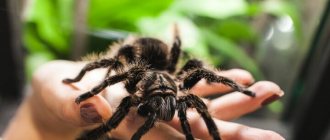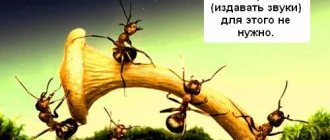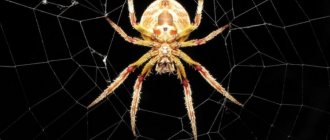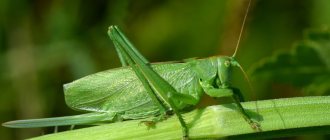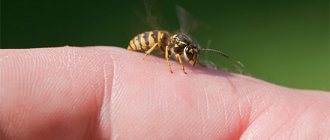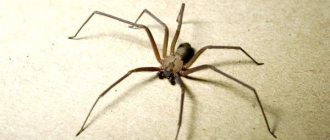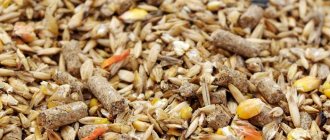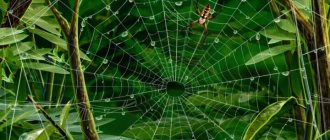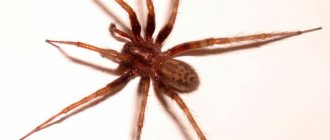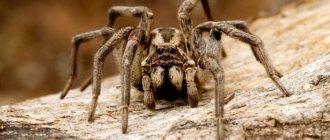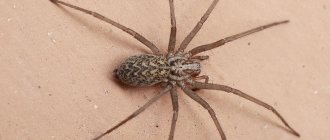4.8
Average rating: 4.8
Total ratings received: 177.
4.8
Average rating: 4.8
Total ratings received: 177.
Animals that are not insects, but were their predecessors in the evolutionary process, are arachnids. This article will help you understand in more detail how this class differs from other representatives of arthropods.
Signs of arachnids
Differences between arachnids and other classes of animals can be found in both the external and internal structure of the body. The external distinctive features of arachnids are:
- Absence of antennae and abdominal limbs;
- The body consists of two sections: the cephalothorax and abdomen;
Individual units of this class have their own characteristics of body structure. For example, a spider has two sections: the cephalothorax and abdomen. The scorpion has a cephalothorax, an anterior abdomen and a posterior abdomen. In mites, the body merges into one section.
- On the cephalothorax there are two pairs near the oral limbs (chelicerae and pedipalps), as well as four pairs of walking legs;
- Terrestrial way of existence.
Fig.1.
External structure of the body Distinctive features in the internal structure of the body include:
- The presence of glands that produce cobwebs, with the help of which some species hunt;
- The eyes have a simple structure;
- The respiratory system is presented in the form of tracheas and pulmonary sacs;
- The excretory system works using the Malpighian vessels;
Digestion partly occurs outside the animal's body. The spider injects poison into the victim caught in the web and wraps it tightly in the web. Under the influence of the poison, the soft tissues of the prey dissolve. After a while, the owner of the web returns and sucks out the nutrient fluid.
This class is one of the many species of animals that are distributed everywhere. The main and well-known examples of arachnids are scorpions, spiders, and ticks.
Reproduction. Development
Fertilization in spiders is internal. The female cross spider is larger than the male. The male transfers sperm to the female's genital opening using special outgrowths located on the front legs.
She lays eggs in a cocoon woven from a thin silky web. The cocoon weaves in various secluded places: under the bark of stumps, under stones. By winter, the female cross spider dies, and the eggs overwinter in a warm cocoon. In the spring, young spiders emerge from them. In the fall, they release cobwebs, and on them, like parachutes, they are carried by the wind over long distances - the spiders disperse.
Spiders
A feature of spiders is the presence of modified abdominal limbs - arachnoid warts. The secret of this gland quickly hardens in open space. With the help of cobweb threads, the animal builds a trapping network. Moreover, it consists of sticky and non-sticky threads. The victim, stuck to the web, is unlikely to be able to escape. The spider descends towards her along non-sticky threads to inject poison, which acts as digestive juice. The hairs on the body are of primary importance in the structure of the body; they play the role of organs of touch.
TOP 4 articles
who are reading along with this
Arachnids
Arachnid legs
Scorpio (arachnid)
Representatives of the Arachnida class
Rice. 2. Construction of the web
Lifestyle
Spiders are unique creatures. Their way of life is completely different from all other living beings on the planet. He is not even similar to other representatives of their class.
Nutrition
Most arachnids are predators. Their diet consists of a variety of insects, small animals and birds. Based on the needs of life, almost all arachnids have to secrete poison, which helps to paralyze or even kill the victim. But you should not assume that this makes them dangerous for humans, because not all representatives of arachnids are capable of harming him. Usually their target is small animals, and spiders are not even able to bite through the skin of large animals or human skin. Or their poison is so weak that it is even harmless. From this we can conclude that there is absolutely no way a person can get into the spider’s diet.
Reproduction
Arachnids are heterosexual creatures. The female is usually larger, but the male has longer limbs. They have bulbuses on their forelimbs - small hammock-like nets containing a drop of sperm. During mating, the male places them in the female's spermatheca. After mating, some males obediently allow themselves to be eaten by the female, while others desperately run away. In any case, female representatives live longer.
After a few days (weeks), the female lays eggs, which she carefully packs into a cocoon-like spider ball. Afterwards she guards this improvised incubator and takes care of it. After all, after birth, small spiders remain inside for some time. They grow and shed there. We can say that females are caring mothers. After some time, the spiders disperse into independent life.
Lifespan
The lifespan of arachnids depends on their species, but most complete their life cycle within one year. Some representatives of the fauna can reach maturity over several years. Some species (for example, Sicarius, found in the deserts of South America and Africa) can live up to 15 years. Arachnids that spin webs live no longer than three years. And even optimal environmental conditions are not conducive to their continued existence. Moreover, 5-6 months are usually spent in the egg stage.
Ticks
Representatives of the order live not only in the environment, they can live in the body of an animal or human, in soil, and plants. Many of them harm agriculture, destroying cultivated plants. Ticks are also dangerous for humans, as they cause various diseases - scabies, encephalitis. But there are types of mites that are beneficial. These are mainly those that live in the soil. With the help of waste products, they fertilize it and participate in the process of formation of fertile soil.
Fig.3. Types of arachnids
Habitat
Arachnids have adapted to land-air and aquatic habitats (both in fresh water bodies and in seas and oceans). They have also adapted to different climatic conditions. Therefore, their species are distributed throughout the globe, except in permafrost areas.
They prefer humid and hot climates rather than temperate or cold ones. For example:
- Jumping spiders live in different habitats - forests, deserts, mountainous areas, brick and stone walls of houses. The diversity of habitats indicates the widespread distribution of the species.
- Tarantula spiders settle in the crowns of equatorial trees and shrubs.
- Digger spiders (tarantulas) and other drought-tolerant species prefer arid areas and live in burrows up to 50 cm deep in large crevices in the ground.
- Haymakers (long-legged animals) occupy cellars, sheds, and dens abandoned by animals.
- Side-walking spiders constantly sit on flowers and patiently wait for hours for their prey to appear; other members of the family are found on the bark of trees or the forest floor.
- The silver spider lives in ponds and rivers with slow currents. He makes his home in water from cobwebs and fills it with air.
- Scorpio has settled on all landmasses, except for some areas of the Arctic, Antarctica and the New Zealand Islands. However, it still prefers warm, arid zones, which is why it is often called a desert animal.
Most species of mites live on the body of a living organism, and some live exclusively on cultivated plants.
Test on the topic
- /10
Question 1 of 10The predecessors of insects are...
Start test
Hall of Fame
To get here, take the test.
- Seryozha Mantserov
6/10
- Valentin Muravyov
8/10
- Max Nefediev
4/10
- Vanya Shevchenko
10/10
Biological significance
Arachnids play a very important biological role for humans and the environment.
For man
Despite the fact that arachnids do not look very attractive, they bring very great benefits to humans. Some peoples eat them as food, others keep them as pets. Scientists are studying arachnids, trying to determine to what extent they can still be useful to people.
Thanks to their predatory lifestyle, spiders destroy a huge number of garden and vegetable pests. Moreover, not only cobwebs can be used, but also poison, which is simply a panacea for aphids and Colorado potato beetles. Entomologists claim that such a product is much safer for the environment than the same pesticides. And much cheaper.
The importance of arachnids from a medical point of view cannot be overestimated. The venom of the tarantula spider is used to produce a drug that calms the nervous system, and it is also used to reduce heart fibrillation during attacks. Currently, the influence of the deadly venom of some types of eight-legged creatures on the treatment of Alzheimer's disease, erectile dysfunction and stroke prevention is being studied.
The web is also very useful. This unusual material is used in various areas of human life. For example, crosshairs for microscopes, telescopes and optical rifle sights are made from it. There were even attempts to establish the production of fabrics from spider webs, but, unfortunately, this process did not become widespread. Because it is not so easy to maintain spider farms due to the excessive gluttony of their inhabitants.
In ecology
Arachnids are natural regulators of insect numbers. They not only exterminate them, but also control the uncontrolled increase in the number of various harmful species. Using only its web, one arachnid can catch up to 400 different insects per day. An undeniable fact is that house spiders destroy insects in people's homes.
It should be noted that arachnids are an integral part of the food chain. They eat insects and are themselves food for other animals. For some species of wasps, arachnids are a kind of incubator in which they place their future offspring, having previously paralyzed their prey.
Place in nature
Spiders are a significant and irreplaceable part of the ecosystem. They are of great importance, performing important functions:
- by feeding on a variety of insects, they regulate their numbers;
- They themselves are food for many animals.
Among those who eat spiders are:
- insects (mantises, blackbirds, scolopendras, wasps);
- spiders (representatives of some species feed on their own kind);
- reptiles (snakes, lizards);
- amphibians (toads, frogs);
- small mammals (hedgehogs, rats, mice, noses).
And, of course, birds feed on spiders, for some of which arachnids are their main food.
